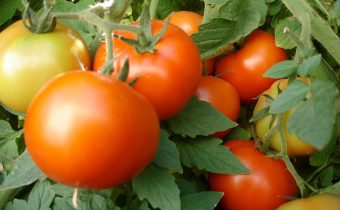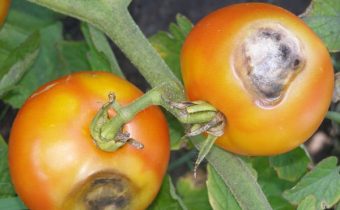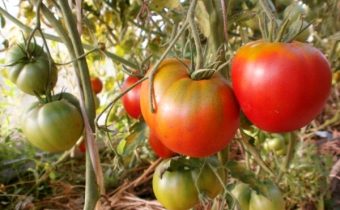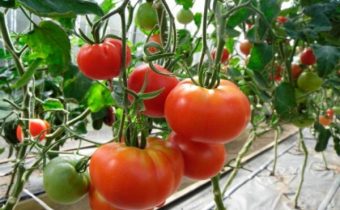How boric acid helps to better tie and ripen tomatoes
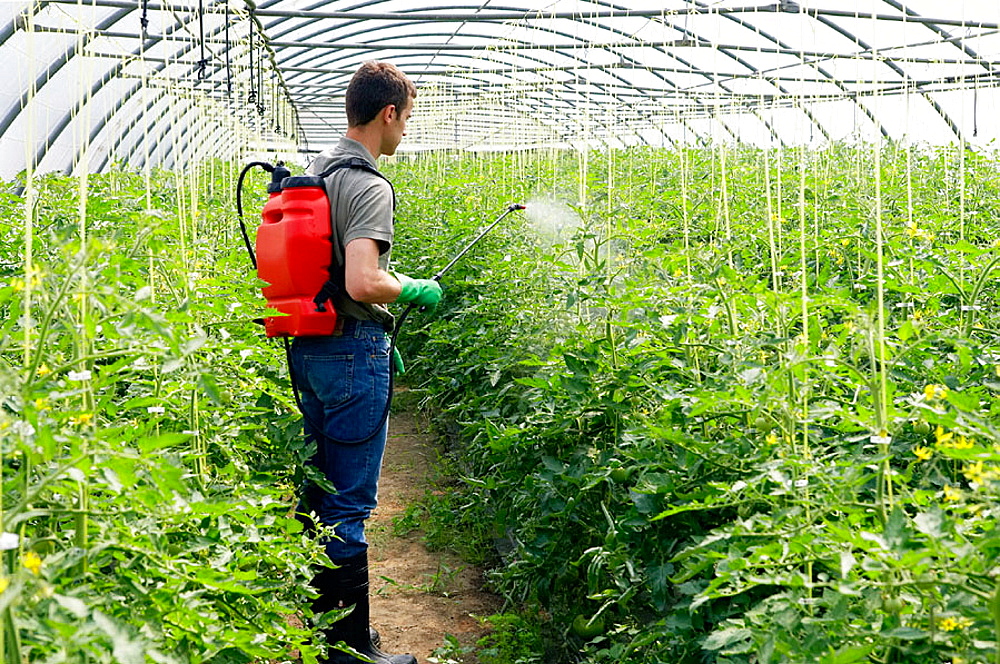
Despite the fact that boron is required for tomatoes in extremely small doses, not only the planting yield, but also the taste of the fruit depends on the element. The concentration of boron in the soil is not always sufficient for adequate plant nutrition, the substance is easily washed out, especially from light, loose soils, which are well suited for growing tomatoes.
Proper fertilizing with boron prevents possible developmental disorders in tomatoes and other vegetable, fruit and ornamental crops.
The value of boron for plants
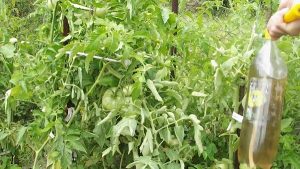 Boron is required for the normal flow of many plant life processes:
Boron is required for the normal flow of many plant life processes:
- the formation of cell walls and calcium absorption - that is, the element is involved in cell division and development;
- metabolism - in particular, affects protein, lipid, carbohydrate, phosphorus and nitrogen metabolism;
- photosynthesis - contributes to the production of chlorophyll;
- transportation of sugars to growing parts of the plant and fruits.
Boron - a valuable substance for all plants, but the most noticeable effect that affects the crop, gives boric feeding of tomatoes.
The benefits of trace elements for tomatoes
The element contributes to the active growth of all parts of plants - leaves, roots, buds, seeds, fruits, which makes it necessary at every stage of the growing season of tomatoes.
- Boron is needed for the development of a strong root system and a good set of green mass, improves the absorption of nutrients from the soil by plants, therefore it is primarily useful for seedlings.
- The element stimulates the formation of flowers, pollination and the formation of ovaries, thereby increasing the volume of fruits on the bushes.
- The substance promotes the pouring of fruits and the accumulation of sugars in their pulp, thereby improving their taste.
With the systematic introduction of boron fertilizing, the fruits of tomatoes ripen a half month earlier than usual.
- Boron increases the resistance of tomatoes to late blight, powdery mildew, verticellosis wilting, and other fungal diseases. The need for an element is especially high in weakened tomatoes suffering from a deficiency of light and nutrition.
- Adding boron to the soil prevents the fruits from rotting due to high humidity, which makes it a valuable tool for greenhouse tomatoes.
Signs of boron deficiency
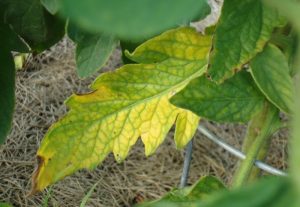 With a noticeable lack of boron, the bushes of tomatoes can stop growing and bear fruit. The deficiency is not always associated with an insufficient content of the trace element in the soil, an excess of calcium, nitrogen or potassium in it prevents the absorption of boron. Abundant irrigation, prolonged drought, cultivation on sandy, calcareous, organic-saturated soils, and adding lime to the soil to reduce acidity contribute to the emergence of boron starvation.
With a noticeable lack of boron, the bushes of tomatoes can stop growing and bear fruit. The deficiency is not always associated with an insufficient content of the trace element in the soil, an excess of calcium, nitrogen or potassium in it prevents the absorption of boron. Abundant irrigation, prolonged drought, cultivation on sandy, calcareous, organic-saturated soils, and adding lime to the soil to reduce acidity contribute to the emergence of boron starvation.
Symptoms of boron deficiency in tomatoes:
- chopping and twisting the upper leaves;
- staining of the vein of the leaf plate in a black or brown tint;
- poor formation of flowers and ovaries on the bush;
- the fall of the ovaries;
- dying off of the apical shoots of the bush;
- intensive growth of lateral shoots, the tops of which also die off over time.
Rules for feeding tomatoes boron
The usual scheme of nutrition of tomatoes with boron includes soil fertilization before planting and foliar dressing during flowering and fruiting.When signs of boron starvation are found, an urgent foliar dressing must be done - application to the soil does not guarantee the assimilation of the element, especially with the speed required in such cases.
Ground application
If the soil parameters do not indicate its susceptibility to rapid loss of boron, you can make a trace element in the composition of ready-made mixtures, which are used for complex fertilizing at the beginning of the growing season of tomatoes. If it is necessary to replenish the boron concentration in the soil (for example, if the soil is sandy and the summer seasons are characterized by an abundance of precipitation), watering with a solution of boric acid will do. Less effectiveness is shown by the introduction of boric acid powder into the wells for planting seedlings - the process of mastering the element will take a long time. It is easier for plants to get boron from a liquid feed.
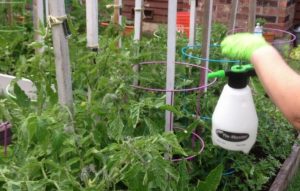 From organic fertilizers, wood ash and peat are high in trace elements. The introduction of ash is optimal for saturation of acidic soils with boron, while lime as a soil acidity worth refusing. Peat has the ability to acidify the soil mixture, so it should be applied to alkaline soils. It should be borne in mind that boron in peat is presented in the form of insoluble or slightly soluble compounds in water, which cannot be absorbed by the plant until decomposition of the fertilizer occurs.
From organic fertilizers, wood ash and peat are high in trace elements. The introduction of ash is optimal for saturation of acidic soils with boron, while lime as a soil acidity worth refusing. Peat has the ability to acidify the soil mixture, so it should be applied to alkaline soils. It should be borne in mind that boron in peat is presented in the form of insoluble or slightly soluble compounds in water, which cannot be absorbed by the plant until decomposition of the fertilizer occurs.
Top dressing with boron for ovaries and tomato ripening
The ability of an element to stimulate the formation of ovaries and the growth of fruits allows it to be used to increase the yield of tomatoes. In this case, foliar feeding is done with a solution of boric acid - spraying over the leaf allows the plants to assimilate the microelement more quickly in comparison with getting it from the soil through the root system.
It is necessary to process with solution all aboveground parts of the plant - leaves, stems, buds, flowers, fruits.
Feeding is carried out 3 times per season:
- in the budding phase;
- during flowering and formation of ovaries;
- at the stage of fruit loading.
Between dressings should sustain a break of at least 10 days. At this time, it is necessary to trace how the plants react to the fertilizer. If the condition of landing has worsened or symptoms of boron poisoning are noticeable, you should not do the following additional feeding.
Spraying is carried out in the morning or in the evening, preferably in cloudy weather. Treatments should be avoided when direct sunlight falls on the bushes so as not to cause burns on the leaves of the tomato.
How to prepare a solution for spraying
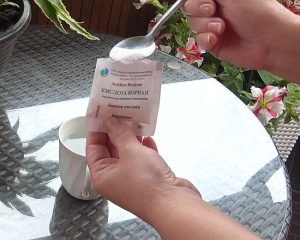 For spraying prepare a 0.05% solution of boron powder (diluted with 5 grams in 10 liters of water). If ovary subsidence occurs, the dose of boric acid in solution should be increased to 1 gram per 1 liter.
For spraying prepare a 0.05% solution of boron powder (diluted with 5 grams in 10 liters of water). If ovary subsidence occurs, the dose of boric acid in solution should be increased to 1 gram per 1 liter.
Dilute boric acid should be water, the temperature of which is about 55 ° C, otherwise the substance is not completely dissolved. Contact of undissolved crystals on the plant causes burns. Cool the solution to room temperature before use. You can dilute the powder in a small amount of hot water, then pour the solution into 10 liters of water.
Side Effects of Boric Nutrition
In an attempt to get the maximum yield, you should know the measure - exceeding the dosage when adding boron or a large number of fertilizing can cause an element poisoning in tomatoes. Since without laboratory analysis it is impossible to determine the boron content in the soil accurately, after each foliar application, it is necessary to monitor the condition of the plants.
Signs of excess item:
- drying of leaves on the lower tier of the bush;
- twisting leaves edge up;
- twisting the tops of the plants.
An excess of boron is dangerous not only by reducing the yield - the substance tends to accumulate in the fruits of tomatoes. Eating such fruits in food adversely affects human health.
Tips and reviews
Alina, 37 years old:
“I use boric acid not only to spray bushes, but also to soak tomato seeds.You need 0.1 grams of acid to 0.5 liters of water, to keep the day before sowing. The tool improves germination well, moreover, seedlings grown from such seeds differ for the better: plants take root more easily after transplantation, among them there are fewer frail and weak ones. I do not water the seedlings myself, so as not to exceed the dose, I leave the boric fertilizer at the time of flowering. Ovaries with such a feed form more. There were cases when boron saved the crop - flowers began to crumble throughout the planting, they were quickly sprayed, they managed to save some of the flowers for the ovary. ”
Anatoly, 42 years:
“I recommend replacing boric acid with boric-magnesium fertilizer (for example,“ Mag-Bor ”). Such fertilizers contain both boric acid and magnesium oxide. Magnesium enhances the effect of boron, plus, in itself, tomatoes also need it, especially when grown in a greenhouse, it is convenient to add 2 elements at once. By the way, you need to pay attention to what other substances are part of the product. For example, "Mag-Bor" contains calcium, and "MonoBor" - nitrogen.
Irina, 46 years old:
“I combine dressing with boron before flowering with the prevention of late blight. A week before the opening of the buds I give foliar feeding with potassium permanganate (pale pink solution, about 5 grams of powder per bucket of water). Then at the beginning of flowering I do spraying with boric acid and in another week - with iodine treatment. Just iodine is useful for the ovaries, a very convenient scheme. Boric solution I make a standard concentration (5 grams per bucket), iodine is diluted 5 drops per liter. I can add a quarter liter of whey to the iodine solution - this is, in principle, additional protection against any fungi. ”
With moderate and systemic application, boric top dressing is an effective means for increasing the yield of tomatoes. If, due to weather or growing conditions, there is a risk of flowers or ovaries falling, fruit with a sour taste will appear, spraying boric acid can prevent problems. But an excess of boron reduces crop yield and makes the fruit unsuitable for human consumption.


